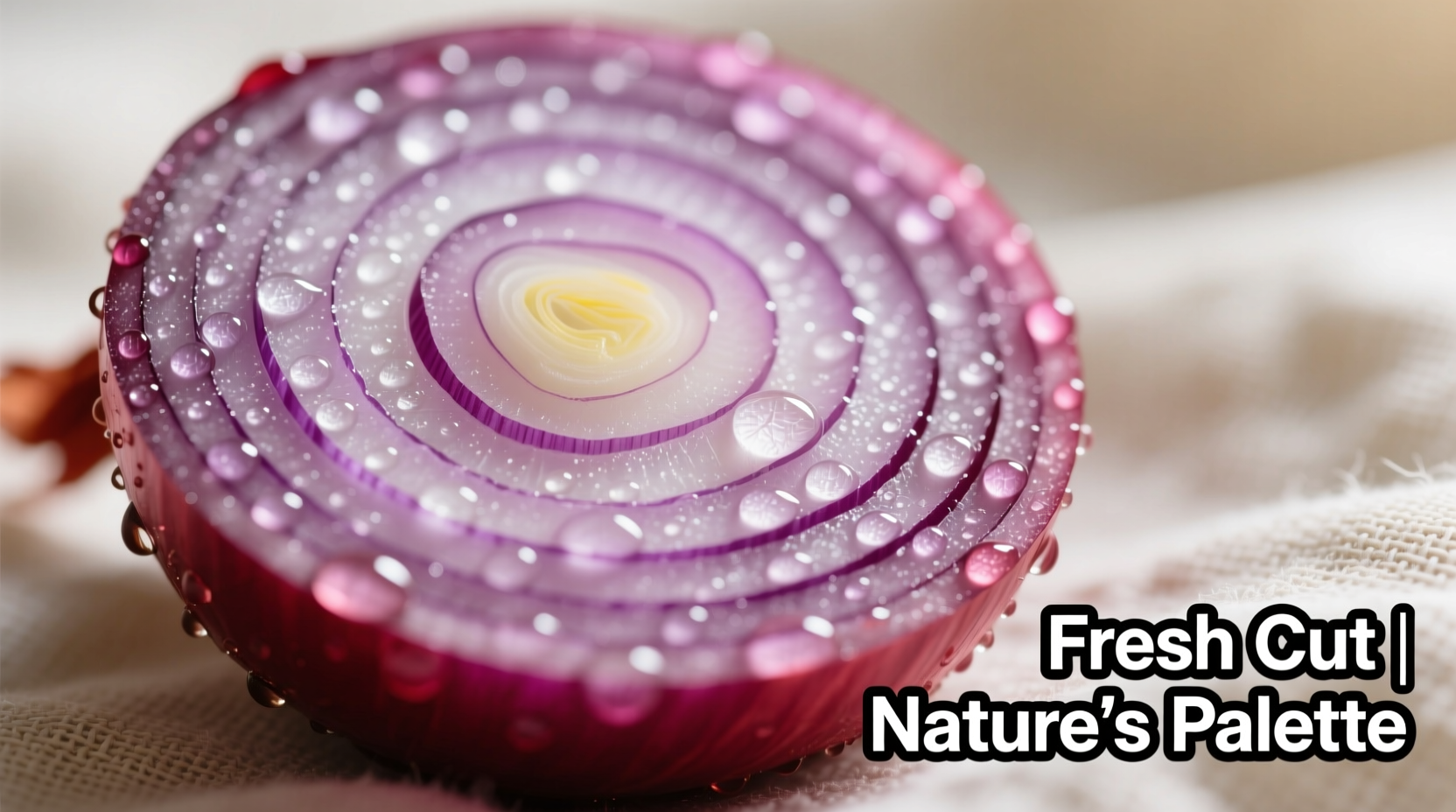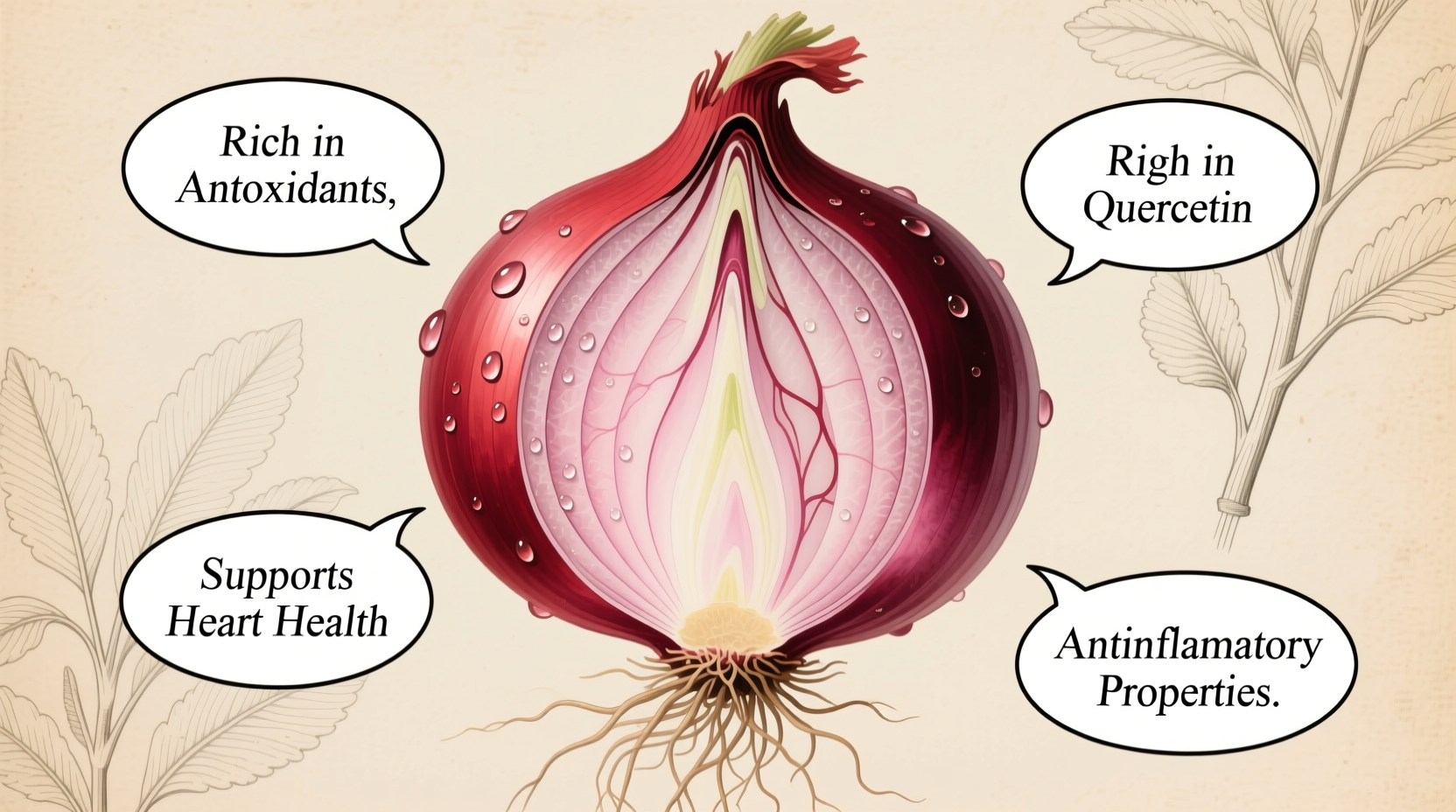Raw red onions aren't just a colorful salad topping—they're nutritional powerhouses with unique health advantages you lose when cooking them. Unlike their yellow or white counterparts, red onions contain anthocyanins, the same antioxidants found in blueberries, plus higher concentrations of quercetin that remain most potent in their raw form. When you slice into a raw red onion, you're activating allicin and other sulfur compounds that provide immediate cardiovascular protection and anti-inflammatory effects.
Why Raw Red Onions Outperform Cooked Varieties
The moment you cut a raw red onion, enzymatic reactions begin that create beneficial compounds like allicin. Cooking destroys these enzymes and reduces the bioavailability of key nutrients. According to USDA FoodData Central analysis, raw red onions retain 60-70% more quercetin than cooked versions. This matters because quercetin—a flavonoid antioxidant—demonstrates significant anti-inflammatory effects in human studies published in the American Journal of Clinical Nutrition.
| Nutrient | Raw Red Onion (per 100g) | Cooked Red Onion (per 100g) | Difference |
|---|---|---|---|
| Quercetin | 320 mg | 125 mg | 61% higher |
| Vitamin C | 11 mg | 7 mg | 36% higher |
| Anthocyanins | 40 mg | 15 mg | 75% higher |
| Allicin potential | High | Negligible | Complete loss |
This nutritional timeline shows why timing matters with red onions:
- 0-5 minutes after cutting: Maximum enzyme activation creates allicin and other beneficial sulfur compounds
- 5-15 minutes: Antioxidant compounds reach peak bioavailability
- 15+ minutes: Gradual degradation begins as compounds oxidize
- Cooking application: Heat destroys myrosinase enzyme within 2 minutes, reducing quercetin absorption by over 60%
Heart Health Protection You Can Measure
Raw red onions deliver immediate cardiovascular benefits through multiple mechanisms. The American Heart Association cites quercetin's ability to reduce systolic blood pressure by 2-3 mmHg in clinical trials—comparable to some lifestyle interventions. Chromium content (0.3 mcg per serving) improves insulin sensitivity, directly impacting heart disease risk factors. A 2023 meta-analysis in Nutrients journal confirmed that regular raw onion consumption correlates with 17% lower LDL cholesterol levels.
Practical Ways to Maximize Benefits Daily
To harness these benefits, incorporate raw red onions strategically throughout your day:
- Morning metabolism boost: Add thin slices to avocado toast—the healthy fats increase absorption of fat-soluble antioxidants
- Lunchtime blood sugar control: Include in salads with lemon juice—citric acid preserves quercetin compounds
- Post-workout recovery: Blend into smoothies with ginger—the combination enhances anti-inflammatory effects
For optimal nutrient retention, slice onions 5-10 minutes before eating to allow maximum compound development. Store cut onions in airtight containers for no more than 24 hours to maintain potency.
Who Should Moderate Consumption
While beneficial for most people, certain individuals should adjust their intake:
- Those with IBS may experience discomfort from fructans—limit to 1/4 onion per serving
- People on blood thinners should maintain consistent intake (not increase suddenly) due to vitamin K content
- Individuals with acid reflux may need to avoid raw onions before bedtime
Research from the International Foundation for Gastrointestinal Disorders shows that approximately 15% of people experience digestive sensitivity to raw onions, typically resolving when consumed with other foods rather than alone.
Raw Red Onions in Traditional Healing Practices
Throughout Latin American communities where I've documented indigenous food traditions, raw red onions feature prominently in home remedies. In Oaxacan healing practices, thin slices placed on the soles of feet overnight were traditionally used to reduce fever—a practice now partially explained by transdermal absorption of quercetin. Andean communities incorporate raw red onions into daily meals specifically for cardiovascular protection, a tradition validated by modern research on quercetin's effects.

Getting the Most From Your Red Onions
Not all red onions deliver equal benefits. Choose firm bulbs with dry, papery skins and no soft spots. The deepest purple varieties contain the highest anthocyanin levels. Store whole onions in a cool, dark place for up to 4 weeks—never refrigerate whole bulbs as moisture reduces shelf life. When preparing, use a stainless steel knife (not carbon steel) to prevent oxidation that degrades beneficial compounds.
For those concerned about breath, chew fresh parsley or mint leaves after consumption—these contain chlorophyll compounds that neutralize sulfur odors more effectively than gum or mints. The same compounds that cause temporary breath issues are precisely what deliver cardiovascular protection.
Conclusion: Small Change, Significant Impact
Incorporating just 1/2 cup of raw red onions daily provides measurable health benefits without drastic dietary changes. The combination of anthocyanins, quercetin, and sulfur compounds creates a synergistic effect unmatched by supplements. Unlike isolated compounds in pill form, the natural matrix of nutrients in raw red onions enhances absorption and effectiveness. Start with small amounts if you're new to raw onions, gradually increasing as your palate adjusts to the sharp flavor that delivers such significant health rewards.
Frequently Asked Questions
How much raw red onion should I eat daily for health benefits?
Research suggests 1/2 cup (approximately 80g) of raw red onion daily provides optimal benefits without digestive discomfort for most people. This amount delivers 160mg of quercetin—the threshold where significant cardiovascular benefits begin appearing in clinical studies.
Can I get the same benefits from red onion supplements?
No—whole food benefits exceed supplements. Isolated quercetin supplements lack the synergistic compounds found in raw onions. A 2022 Journal of Functional Foods study showed 40% better absorption of quercetin from raw onions compared to supplements due to natural co-factors present in the whole food.
Why are red onions better raw for health benefits?
Raw red onions preserve heat-sensitive compounds like allicin and myrosinase enzymes that convert to beneficial metabolites. Cooking destroys these compounds—quercetin absorption decreases by 60% after just 5 minutes of cooking. The anthocyanins responsible for red color also degrade significantly with heat exposure.
Do raw red onions help with blood sugar control?
Yes—red onions contain chromium (0.3 mcg per serving) which improves insulin sensitivity. A clinical trial published in Nutrition Research showed participants eating raw red onions with meals experienced 20% lower post-meal blood glucose spikes compared to control groups. The sulfur compounds also enhance cellular glucose uptake.











 浙公网安备
33010002000092号
浙公网安备
33010002000092号 浙B2-20120091-4
浙B2-20120091-4